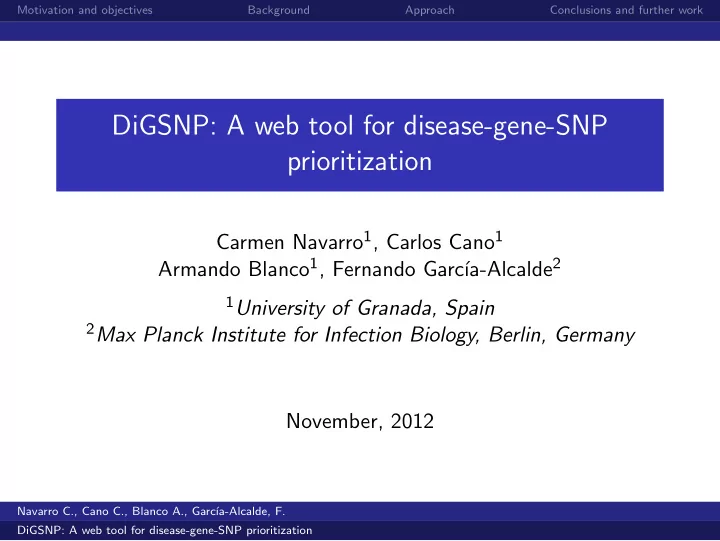

Motivation and objectives Background Approach Conclusions and further work DiGSNP: A web tool for disease-gene-SNP prioritization Carmen Navarro 1 , Carlos Cano 1 Armando Blanco 1 , Fernando Garc´ ıa-Alcalde 2 1 University of Granada, Spain 2 Max Planck Institute for Infection Biology, Berlin, Germany November, 2012 Navarro C., Cano C., Blanco A., Garc´ ıa-Alcalde, F. DiGSNP: A web tool for disease-gene-SNP prioritization
Motivation and objectives Background Approach Conclusions and further work Index 1 Motivation and objectives 2 Background 3 Approach 4 Conclusions and further work Navarro C., Cano C., Blanco A., Garc´ ıa-Alcalde, F. DiGSNP: A web tool for disease-gene-SNP prioritization
Motivation and objectives Background Approach Conclusions and further work Motivation and Objectives Context Next-Generation Sequencing: decreasing cost, raising throughput. Increasing availability of large amounts genome information. Motivation Personalized medicine : improve diagnosis, disease prevention and treatment based on individual genomical information. Aim: Relate diseases - individual genomical information . Required: Efficient computational tools that produce useful, summarized results. Navarro C., Cano C., Blanco A., Garc´ ıa-Alcalde, F. DiGSNP: A web tool for disease-gene-SNP prioritization
Motivation and objectives Background Approach Conclusions and further work Motivation and Objectives Objectives Support development of personalized medicine, by: Helping discover putative mutations and genes related to a query disease. Reducing search space to a reliable, manageable set of candidate genes and SNPs. Guiding further research on the most promising hypotheses. Navarro C., Cano C., Blanco A., Garc´ ıa-Alcalde, F. DiGSNP: A web tool for disease-gene-SNP prioritization
Motivation and objectives Background Approach Conclusions and further work Background Disease-gene prioritization Many methods for disease-gene prioritization. Most do not consider genome variations (i.e. SNPs, insertions, deletions). Variations are cause for many diseases. Navarro C., Cano C., Blanco A., Garc´ ıa-Alcalde, F. DiGSNP: A web tool for disease-gene-SNP prioritization
Motivation and objectives Background Approach Conclusions and further work Background SNP prioritization Relating variations directly to diseases: gene relationship with disease is left out or implicit. Many require experimental evidence, such as GWAS studies: difficult to start research on new or rare diseases. Most focused on coding regions. Important regulatory regions: SNPs altering TFBSs . Navarro C., Cano C., Blanco A., Garc´ ıa-Alcalde, F. DiGSNP: A web tool for disease-gene-SNP prioritization
Motivation and objectives Background Approach Conclusions and further work DiGSNP Features Relates diseases, genes and SNPs at once . Two-level hierarchy : Disease-gene. Gene-SNP. Disease-gene prioritization using ProphNet . SNP scoring with IntuitSNP intuitionistic approach. Gene-SNP relations: dbSNP. Navarro C., Cano C., Blanco A., Garc´ ıa-Alcalde, F. DiGSNP: A web tool for disease-gene-SNP prioritization
Motivation and objectives Background Approach Conclusions and further work ProphNet Description Used for disease-gene prioritization. Network-based prioritization tool. Integrates data from an arbitrary set of sources. Prioritizes a Target Set based on how related this is to a Query Set. Used sources: OMIM, HPRD, DOMINE, InterDom, Pfam. Navarro C., Cano C., Blanco A., Garc´ ıa-Alcalde, F. DiGSNP: A web tool for disease-gene-SNP prioritization
Motivation and objectives Background Approach Conclusions and further work IntuitSNP Description Calculation based on intuitionistic similarity score motif-sequence: SC intuit SNPs that drastically alter a motif’s binding affinity: Top candidate regulatory SNPs. For each gene obtained in prioritized list: Query dbSNP for SNPs in regulatory regions. Obtain their IntuitSNP score. Order them in descending order based on the difference between wild-type and mutated scores. Navarro C., Cano C., Blanco A., Garc´ ıa-Alcalde, F. DiGSNP: A web tool for disease-gene-SNP prioritization
Motivation and objectives Background Approach Conclusions and further work DiGSNP workflow Navarro C., Cano C., Blanco A., Garc´ ıa-Alcalde, F. DiGSNP: A web tool for disease-gene-SNP prioritization
Motivation and objectives Background Approach Conclusions and further work DiGSNP Web tool DiGSNP is available at http://genome2.ugr.es/digsnp Efficient : Results within 2-3 minutes. Intuitive : Visually understandable results set. Cross-referenced with several information sources (e.g. dbSNP, Jaspar). Navarro C., Cano C., Blanco A., Garc´ ıa-Alcalde, F. DiGSNP: A web tool for disease-gene-SNP prioritization
Motivation and objectives Background Approach Conclusions and further work Results Validation data Systematic validation difficult: Lack of variations-genes-diseases resources for validation. putative rSNPs # cited % cited dbSNP 576.440 3994 0,69 HMGD (pub.) 576.440 1582 0,27 HMGD (subscr.) 576.440 2542 0,44 Navarro C., Cano C., Blanco A., Garc´ ıa-Alcalde, F. DiGSNP: A web tool for disease-gene-SNP prioritization
Motivation and objectives Background Approach Conclusions and further work Results Validation Currently gathering a larger dataset to better validate results: dbSNP’s medical references . HMGD public available citations. RegulomeDB : Recent curated database with regulatory information of SNPs. Preliminary results consistent with medical literature. Navarro C., Cano C., Blanco A., Garc´ ıa-Alcalde, F. DiGSNP: A web tool for disease-gene-SNP prioritization
Motivation and objectives Background Approach Conclusions and further work Results for Breast Cancer Gene ProphNet score SNP id Function Motif Motif score RAD51 0,527 rs150213086 UTR5 C-MAF 0,335 rs1801320 Kid3 0,319 UTR5 rs183455067 DWN500B Kid3 0,319 rs184898629 UP2K Kid3 0,319 rs187471538 UP2K Kid3 0,319 rs7180135 Kid3 0,319 UTR3 BRCA2 0,519 rs145901536 UP2K Kid3 0,319 rs10492394 ZNF333 0,300 UP2K rs187284594 UP2K ZNF333 0,300 rs79681965 HMGIY 0,289 DWN500B rs185674638 UTR3 HMGIY 0,279 rs55641815 Churchill 0,278 UTR5 BRCA1 0,452 rs191995002 DWN500B C-MAF 0,327 rs148196794 UTR5 Kid3 0,319 rs80356827 C-MAF 0,294 UTR5 Navarro C., Cano C., Blanco A., Garc´ ıa-Alcalde, F. DiGSNP: A web tool for disease-gene-SNP prioritization
Motivation and objectives Background Approach Conclusions and further work Conclusions DiGSNP is helpful for early stage research . Suggestions made based on genomic information, motifs and binding affinity. No need for previous experimental results (i.e. GWAS, previous publications). Focus on regulatory variations . Useful tool as a start point to boost further research . Navarro C., Cano C., Blanco A., Garc´ ıa-Alcalde, F. DiGSNP: A web tool for disease-gene-SNP prioritization
Motivation and objectives Background Approach Conclusions and further work Further work Integrate coding variations. Influence of variation function class to score. User-defined SNP ranking. Navarro C., Cano C., Blanco A., Garc´ ıa-Alcalde, F. DiGSNP: A web tool for disease-gene-SNP prioritization
Recommend
More recommend